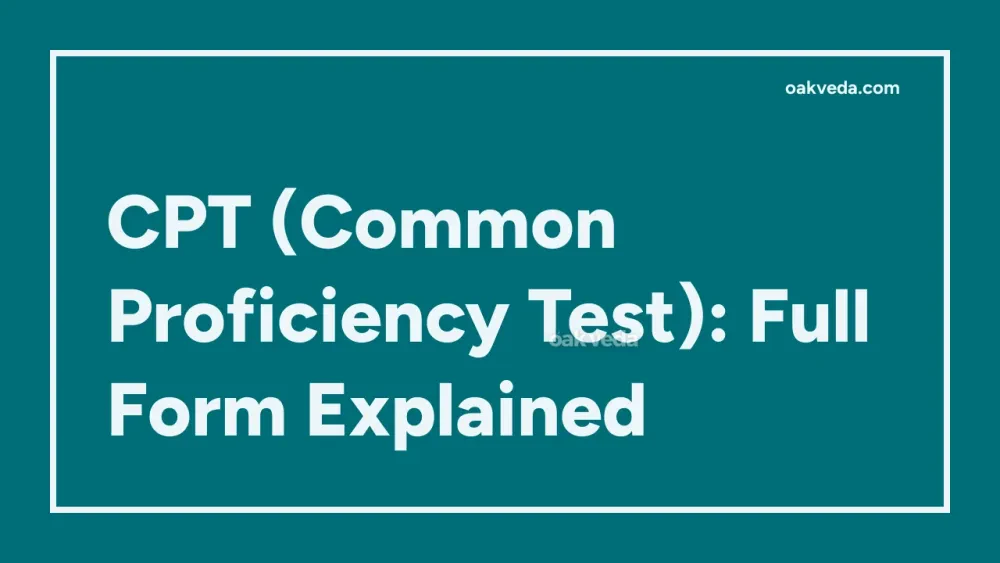
What is the Full Form of CPT?
The full form of CPT is Common Proficiency Test. This entry-level examination is a crucial step for individuals aspiring to become Chartered Accountants in India. Conducted by the Institute of Chartered Accountants of India (ICAI), the CPT serves as the gateway to the prestigious Chartered Accountancy course.
What is Common Proficiency Test?
The Common Proficiency Test, often referred to as CA-CPT, is a standardized examination designed to assess the foundational knowledge and skills of candidates seeking to pursue a career in Chartered Accountancy. As the first step in the CA journey, the CPT evaluates students' proficiency in key areas essential for success in the field of accounting and finance.
Origin and Development of Common Proficiency Test
The ICAI introduced the Common Proficiency Test in 2006 as part of its efforts to streamline the Chartered Accountancy curriculum and ensure that candidates possess the necessary aptitude and basic understanding before progressing to more advanced stages of the course. This reform aimed to maintain the high standards of the CA profession while making the initial entry more accessible to a wider pool of talented individuals.
How does Common Proficiency Test work?
The CPT is typically conducted twice a year, in June and December. The examination follows a multiple-choice question (MCQ) format, testing candidates' knowledge across four key subject areas. The test is designed to evaluate not only theoretical understanding but also practical application and problem-solving skills.
Functions of Common Proficiency Test
The primary functions of the Common Proficiency Test include:
- Screening: It serves as an initial filter to identify candidates with the potential to excel in the field of Chartered Accountancy.
- Foundation Building: The CPT syllabus covers fundamental concepts, laying a strong foundation for future studies.
- Standardization: It ensures a uniform assessment of candidates from diverse educational backgrounds across India.
- Skill Assessment: The exam evaluates critical thinking, analytical skills, and basic numerical aptitude.
Applications of Common Proficiency Test
The CPT has several important applications:
- Entry to CA Course: Successful completion of the CPT is mandatory for enrollment in the Intermediate level of the CA course.
- Career Guidance: Performance in different sections can help students identify their strengths and areas for improvement.
- Academic Benchmarking: It sets a standard for the level of knowledge expected from aspiring Chartered Accountants.
Features of Common Proficiency Test
Key features of the Common Proficiency Test include:
- Objective Format: The exam consists entirely of multiple-choice questions, ensuring uniform and unbiased evaluation.
- Comprehensive Coverage: It tests knowledge across four crucial subjects relevant to the CA profession.
- Time-Bound: The examination is conducted within a fixed duration, assessing candidates' ability to manage time effectively.
- Negative Marking: To discourage guesswork, there is a penalty for incorrect answers.
- Bilingual Option: The exam is available in both English and Hindi, catering to a diverse student population.
Benefits of Common Proficiency Test
The CPT offers several benefits to both students and the accounting profession:
- Early Career Direction: It allows students to gauge their aptitude for the CA profession at an early stage.
- Cost-Effective: As an entry-level exam, it helps students assess their suitability before committing to the full CA course.
- Skill Development: Preparation for CPT enhances fundamental skills crucial for a career in accounting and finance.
- Standardized Evaluation: It ensures that all candidates entering the CA course meet a minimum standard of knowledge and skills.
Limitations or Challenges of Common Proficiency Test
While the CPT serves its purpose effectively, there are some limitations:
- Limited Depth: As an entry-level test, it cannot cover advanced concepts in great detail.
- Pressure on Young Students: The exam can be challenging for students who have just completed their 12th standard.
- MCQ Format Limitations: The objective format may not fully assess a candidate's analytical and writing skills.
Future Developments in Common Proficiency Test
The ICAI continually reviews and updates its examination patterns to align with evolving industry needs. Potential future developments may include:
- Integration of computer-based testing for enhanced efficiency and security.
- Inclusion of new subjects or topics to reflect changing business environments.
- Possible modifications to the exam structure or frequency based on feedback and analysis.
FAQs on CPT Full Form
-
What is the eligibility criteria for CPT? Candidates must have completed or be pursuing their 10+2 examination from a recognized board.
-
How many times can one attempt the CPT? There is no limit on the number of attempts for CPT.
-
Is CPT mandatory for all CA aspirants? While CPT is the standard entry route, graduates can opt for direct entry to the Intermediate level under certain conditions.
-
What are the main subjects covered in CPT? The four main subjects are Fundamentals of Accounting, Mercantile Laws, General Economics, and Quantitative Aptitude.
-
How is the CPT scored? The exam is scored on a 200-point scale, with a minimum of 30% required in each section and an aggregate of 50% to pass.
In conclusion, the Common Proficiency Test, the full form of CPT, plays a vital role in shaping the future of Chartered Accountancy in India. By providing a standardized, comprehensive assessment of foundational knowledge, it ensures that only the most capable and dedicated candidates progress in this challenging and rewarding profession.
You may be interested in:

